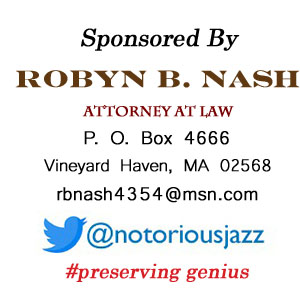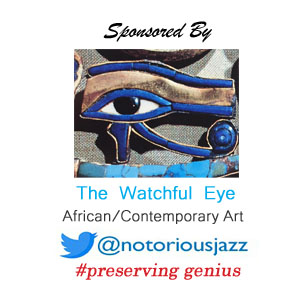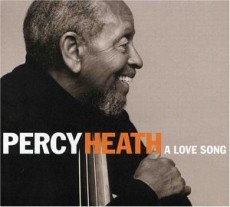
Daily Dose Of Jazz…
Percy Heath was born on April 30, 1923 in Wilmington, N.C. but was raised in Philadelphia. The second of four children, he was the brother of saxophonist Jimmy Heath and drummer Albert “Tootie” Heath. With music in the house, as a child Percy started playing violin at eight but it wasn’t until after serving as a Tuskegee Airman during WWII that he took up the bass. After a stint in music school he was playing in Philly clubs, ventured to Chicago in 1948 to record a Milt Jackson session with his brother. Moving to New York he worked with Joe Morris, Johnny Griffin and Dizzy Gillespie.
Working with Dizzy were pianist John Lewis, drummer Kenny Clarke, vibist Milt Jackson and bassist Ray Brown who would become the Modern Jazz Quartet. When Ray decided to leave to become a part of his wife Ella Fitzgerald’s band, Percy stepped into the position and the MJQ was officially launched in 1952, with Connie Kay replacing Clarke shortly after.
In 1975 along with brothers Jimmy and Albert and Stanley Cowell, he formed the Heath Brothers, sometimes playing cello when recording a series of albums. Over the course of his lifetime he played and recorded with such notables as Miles Davis, Charlie Parker, Wes Montgomery, Thelonious Monk and Dizzy Gillespie.
After a second bout with bone cancer Percy Heath passed away on April 28, 2005 in Southampton, New York. His final recording A Love Song garnered critical acclaim and was a fitting tribute to his long and illustrious career.
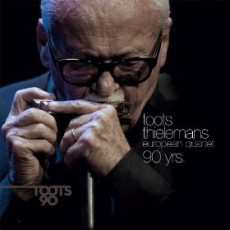
Daily Dose Of Jazz…
Jean-Baptiste Frédéric Isidor Baron Thielemans was born on April 29, 1922 in Brussels, Belgium. Known to the world as Toots, he began his musical training on accordion at age three. Not playing harmonica until he was seventeen, Toots original reputation was made as a guitarist greatly influenced by Django Reinhardt. By 1949 he was sharing the Paris Jazz Festival bandstand with Charlie Parker, Miles Davis, Max Roach and Sidney Bechet for a jam session. That same year he began touring Europe with Benny Goodman and making his recording debut with Zoot Sims.
Moving to the US in 1952 he joined Charlie Parker’s All-Stars and worked with Miles Davis and Dinah Washington. He played and recorded with names like Ella Fitzgerald, Peggy Lee, George Shearing, Quincy Jones, Oscar Peterson, Bill Evans, Paul Simon, Billy Joel, The Happenings, Astrud Gilberto, Shirley Horn, Elis Regina and others.
His composition “Bluesette”, recorded in 1962, where he introduced whistling and guitar in unison, has become a jazz standard. Norman Gimbel later penned the lyrics and the tune became a worldwide hit for several singers and is still highly requested.
His trademark harmonica playing and whistling has been heard in movie scores, television series and commercials. He has been a proponent of world music releasing a French flavored album Chez Toots and the two-volume Brasil Project. He has received honorary doctorates, made a baron by King Albert II of Belgium, and in 2008 became a NEA Jazz Master.
Apart from his popularity as an accomplished musician, he is well liked for his modesty and kind demeanor. The composer and musician continued to play and record until he passed away on August 22, 2016 in Braine-l’Alleud, Belgium. He is credited with single-handedly introducing the chromatic harmonica as a jazz instrument in the Fifties, playing with the dexterity of a saxophone.
More Posts: harmonica
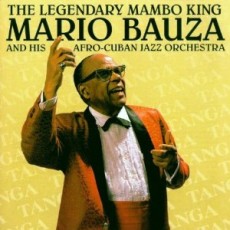
Daily Dose Of Jazz…
Mario Bauzá was born on April 28, 1911 in Havana, Cuba and was classically trained. By age nine he was playing clarinet in the Havana Philharmonic Orchestra and would stay there for the next three years. In 1925 he ventured to New York to record with Maestro Antonio Maria Romeu’s band “Charanga Francesca”. He was fourteen. Five years later he returned to New York and reputedly learned to play trumpet in two weeks to become a part of the Don Azpiazu Orchestra.
Bauzá became lead trumpeter and musical director for Chick Webb’s Orchestra by 1933, and it was during his time with Webb that Bauzá both met fellow trumpeter Dizzy Gillespie and discovered and brought into the band singer Ella Fitzgerald. 1938 saw Bauzá joining Cab Calloway’s band, later convincing Calloway to hire Dizzy as well, with whom Bauzá would continue to collaborate even several years after he left Calloway’s band in 1940. The fusion of Bauzá’s Cuban musical heritage and Gillespie’s advancements in bebop eventually culminated in the development of cubop, one of the first forms of what is commonly referred to as Latin jazz.
Bauzá became musical director of Machito and his Afro-Cubans in 1941, a band led by his brother-in-law, Frank Grillo, also known as Machito, and in 1942 he brought a young timbales player named Tito Puente into the fold. For the next 30 years Bauzá remained director of the band up until 1976 where he began working sparingly leading his own Afro-Cuban orchestra through the eighties and into the early 90s, where his last band made a guest appearance on The Cosby Show.
Mario Bauzá, who died in New York City on July 11, 1993, was one of the first musicians to introduce Latin music to the United States by bringing Cuban musical styles into the New York jazz scene. He was one of the most influential figures in the development of Afro-Cuban music, and his innovative work and musical contributions have many jazz historians to call him the “Founding Father of Latin Jazz”.
More Posts: bandleader,clarinet,trumpet
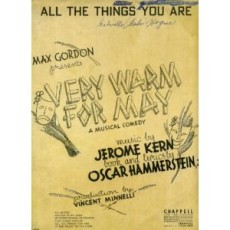
From Broadway To 52nd Street
Very Warm For May opened at the Alvin Theatre on November 17, 1939. Vincente Minnelli directed the play and the music was scored by Jerome Kern and Oscar Hammerstein, producing such favorites at the time as “All In Fun” and “In The Heart Of The Dark” but it was “All The Things You Are” that went on to become a jazz standard. However, the musical that starred June Allyson, Eve Arden and Vera-Ellen ran on Broadway for only two months, received mixed reviews and closed after only 59 performances.
The Story: The plot that had Long Island society girl May Graham fleeing threatening gangsters and hiding out with an avant-garde summer stock troupe in Connecticut. The first version of the show, which opened out of town, received rave reviews and played to sold-out houses. However, producer Max Gordon had been away when the show opened out of town and when he saw it, he hated the gangster subplot and had it removed. This could have been a contributing factor to the mixed reviews and the audience enjoyment.
Broadway History: Broadway was originally the Wickquasgeck Trail, carved into the brush destination of Manhattan by its indigenous Native American inhabitants.This trail originally snaked through swamps and rocks along the length of Manhattan Island.
Upon the arrival of the Dutch, the trail soon became the main road through the island from Nieuw Amsterdam at the southern tip. The Dutch explorer and entrepreneur David de Vries gives the first mention of the trail in his journal for the year 1642, “the Wickquasgeck Road over which the Indians passed daily”. Although current street signs are simply labeled as “Broadway”, in a 1776 map of New York City, Broadway is explicitly labeled “Broadway Street”.In the mid-eighteenth century, part of Broadway in what is now lower Manhattan was known as Great George Street.
Sponsored By
www.whatissuitetabu.com
More Posts: broadway
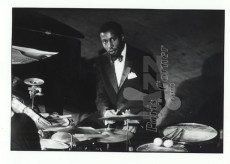
Daily Dose Of Jazz…
Connie Kay, the drummer for the longstanding Modern Jazz Quartet was born Conrad Henry Kirnon on April 27, 1927, in Tuckahoe, New York. The self-taught drummer played with Sir Charles Thompson in the 40s along with Miles Davis and Cat Anderson.
By the late forties to the mid-fifties he played off and on with Lester Young, Beryl Booker, Stan Getz, Coleman Hawkins, Charlie Parker and others. But it wasn’t until 1955 when replacing Kenny Clarke, that Kay found his home with the Modern Jazz Quartet, an association that would last nearly twenty years.
After the dissolution of the MJQ, Connie played with Chet Baker, Cannonball Adderley, Jimmy Heath, Jim Hall and Paul Desmond. In the 70s he worked with Tommy Flanagan, Soprano Summit, Benny Goodman and became the house drummer at Eddie Condon’s club.
In 1981 the MJQ reorganized to play festivals and later on a permanent six-months-per-year basis. When Kay’s health began to suffer, the drummer was replaced first by Mickey Roker and then by Albert “Tootie” Heath.
Kay was known for his subtle and quietly effortless playing with the MJQ, but beyond that memorable interaction he was an invaluable asset to everyone he came in contact with. He played with great discretion and restraint making his contribution to one of the great aggregations of all time.
Connie Kay died in New York City on 30 November 1994. He was sixty-seven years old.
More Posts: drums



